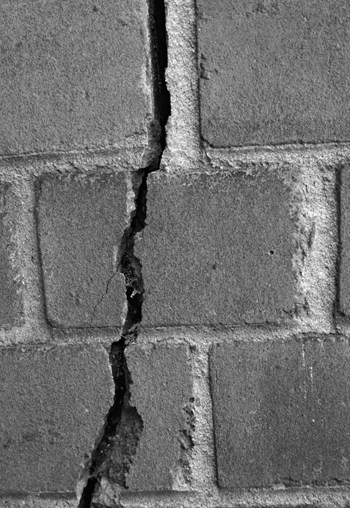
The facade is the first thing your residents and their guests see when they approach and enter your building. It's the aesthetic face of your community, as well as another layer of protection against the elements. Even though it may be made of limestone, brick, or steel and heavy-duty glass, a building's facade is far from invulnerable. Without good upkeep, your building's skin can suffer from an array of insults, from construction defects to everyday wear-and-tear—and a beat-up exterior may be indicative of more things going wrong inside.
Good Design, Good Maintenance
Part of any building’s maintenance plan should include protecting it against its enemies, repairing any damage and maintaining the building exterior on a regular basis. Neglecting the outside of the building can lead to worsening conditions and ultimately cause a hefty dent in your building’s bottom line. By maintaining the building, you are actually slowing down its deterioration.
Of course, the perfect scenario would be to manage a building whose façade is in tip top condition—but according to Mark Williams, president of Williams Building Diagnostics in Maple Glen, Pennsylvania, some buildings are born with facade problems, so to speak. A building’s façade should be well-designed and properly constructed from the start to avoid costly and potentially dangerous situations—if they're not, no amount of maintenance or repair is likely to fend off big problems for long.
“If you are managing a building that inherently has a design flaw or construction problem, it’s difficult to overcome those with whatever maintenance you may do,” says Williams. “Some buildings just have things that are built into them that are problematic— how they handle water, for example. If the [drainage] concept is inappropriate for the building, you can be dealing with a problem right off the bat.”
For example, another construction consultant working in Jersey City recalls a condo building whose façade was so poorly constructed and maintained that the occupants had to be moved to temporary accommodations while the building was stripped and reclad—or covered—again. The project cost millions, and shockingly, the building was less than five years old—almost brand-new, yet showing damage that a building ten times its age might not even have.
But even if you’re fortunate to manage or live in a well-designed, well-built building, it’s still important to schedule regular inspections and maintenance to prevent problems such as leaks, cracking and crumbling from turning into devastating situations. Leaks can lead to damage within the walls and the units and cracking and crumbling can lead to pieces of the façade falling from the building. In October 2009, an eight-year-old girl was hit on the head by falling debris from a vacant building in Newark. The building might have been vacant, but situations like this can happen in occupied buildings just as easily.
Understanding what kind of damage a building's facade is most vulnerable to depends on knowing what the structure is made of. The most common materials for building facades in New Jersey are brick, stucco, or quarried stone such as limestone. “Stone, brick, metal and wood all have drastically different life spans and tolerances,” says Frederick C. Baumert, principal of Keast & Hood Co. Structural Engineers in Philadelphia, a company that has worked on Philadelphia’s historic town hall.
“While we still see some of the more typical masonry buildings [in urban areas],” says Russell Fernandes of Becht Engineering in Liberty Corner, “more lately we're seeing some of the newer technology systems, such as the Exterior Insulation and Finish Systems, or EIFS. EIFS looks like stucco but consists of a foam insulation board for exterior insulation with a hard, stucco-like exterior finishing coat that can be installed in a variety of colors and patterns.”
“We also are seeing 'thin' or faux brick systems.These systems have the appearance of a traditional masonry facade but are actually constructed of half-inch-thick, brick-like pieces inserted in a backing grid installed directly onto the wall sheathing. The spaces between the thin units are then grouted with mortar.”
Water is Trouble
No matter what the material, however, the number one factor that can ruin any type of façade is water. “Water intrusion and insufficient drainage can pose a potential threat to the durability and usability of residential construction and are an important concern to the building and construction products industries,” says Williams.
“All masonry absorbs water,” says Garth Hall, a consulting architect at Raths, Raths & Johnson Inc., in Chicago. “If it’s absorbing water in cold climates and then freezes, it will damage the masonry and begin to crack. The more absorption, the more the continuation of the deterioration.”
Once water gets into the building, it’s destructive. Wet or damp drywall, caulking, grout, wood, or carpet can become moldy. When the mold is disturbed, spores are released into the air. When inhaled, mold spores can cause serious health damage. Water can also cause the façade to crumble and crack.
There are vapor barriers and sealants that can be used to fill cracks and openings that might allow moisture to enter the building. To prevent the water from intruding, there are two types of barriers that are used inside the façade. The first, a face-sealed barrier, means the water is excluded at the face of the building, but this type of barrier has its limitations. “It’s hard to get them to be 100 percent water-tight,” says Williams. “If some water gets in, it can cause problems.”
The second barrier, a concealed barrier, is more common with a stucco façade. Concealed barrier walls rely on multiple layers to control the rain from getting in. These barriers include a drainage plane, or water barrier too.
Stop the Air, Ditch the Dirt
It might not seem so, but air movement can also lead to problems inside a façade. “Look at the air and thermal movement in a building,” Williams says. “Air can carry moisture and if air is allowed to penetrate through the building enclosures, you can end up with problems.”
Cracks and freeze-thaw are examples of what can happen when there is movement of air and moisture in the building. Freeze-thaw is when water seeps into a crack with the air, then freezes causing the area to enlarge and ultimately crack.
Dirt, besides looking bad, can also break down the composition of many things, including facades. Pollution in the air, combined with acid rain can damage stone facades, especially limestone. It can also create a buildup of lime deposits, which, over time, steadily breaks down the stone. It’s important to have the building cleaned every few years.
“Cleaning the building is different from maintaining it,” says Hall. “In this economic climate, other than window washers in high-rise buildings, you don’t see a lot of proactive cleaning. It tends to be more reactionary because of water leakage or visible defects.”
How a building is cleaned depends on the material it’s made from, Hall continues. “With stone and brick, the material is porous and you don’t want to force water into it because it causes damage,” he says. “There are acidic products to clean masonry, depending on the material, to avoid that.”
Inspections
Maintaining any type of façade first requires a full inspection by a qualified professional to look for potential sources of water infiltration or any damage that may exist. In New Jersey, façade inspectors can be anyone involved in the design construction of a building. For example, a licensed architect or engineer can take responsibility for these inspections.
“There are several ways that these inspections can be made,” says Fernandes. “Initial inspections can be made from [the ground], utilizing binoculars and zoom lenses, as well as from rooftops and windows or balconies of adjacent buildings.
However, he explains that for a truly complete and thorough inspection, there is no substitution for an up-close inspection from a scaffold or boom lift.
“The type of damage and the necessary repairs or maintenance procedures will vary depending on the type of façade system,” says Fernandes.“For example, a glass-and-steel curtain wall system is reliant on caulk and rubber seals, either of which may require replacement over time. The steel or aluminum trim elements may require cleaning and/or repainting, if for no other reason than to retain the aesthetics of the building.Maintaining a limestone or masonry building will involve replacing—or 'repointing'—the mortar between the individual bricks or stones, as well as re-caulking joints around windows, doors and other penetrations.”
In New York City, a series of local laws require that building facades be subjected to periodic inspections. The laws were enacted to prevent or reduce damage to property, as well as injury or death to pedestrians from falling debris. New Jersey has no such law, but HOA administrators should follow the standards set forth by the American Society for Testing and Materials International (ASTM) which require periodic inspections of facades for unsafe conditions. “Any number of cities have adopted them,” says Williams, “but they picked pieces of [ASTM's recommendations] and developed their own façade inspection requirements.”
On the other hand, says Hall, “New Jersey does have maintenance requirements for buildings that are within historic districts,” or which have been declared historic preservation sites.
“Inspectors look for loose materials or dangerous conditions, which often requires destructive testing, which means that [inspectors] have to remove a small piece for testing to make sure there’s no steel corrosion, etc.”
During lean economic times, buildings may be tempted to save a few bucks by putting off minor repairs, including façade work. Tempting as it may be, the consequences of ignoring a minor problem now, can lead to much bigger and costlier problems down the road. Putting off minor exterior maintenance can lead to serious deterioration and a building that once had a small repair—even on an exterior accessory—now has hundreds of thousands of dollars in damage. Don’t wait until something happens before you fix it. Regular inspections and maintenance are a vital part of a maintenance and safety program for any building.
Lisa Iannucci is a freelance writer, author and a frequent contributor to The New Jersey Cooperator.






Leave a Comment